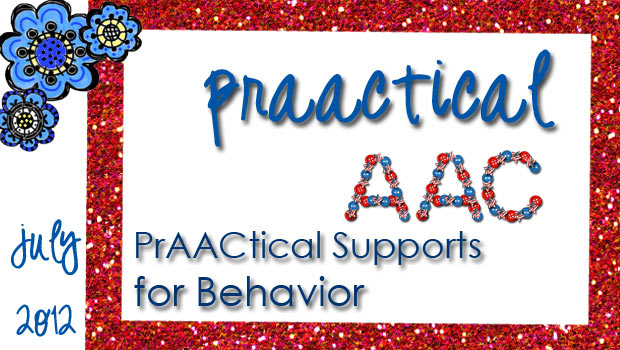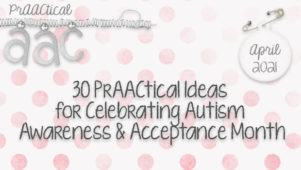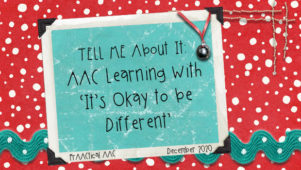PrAACtical Supports for Behavior

Rachel arrives to therapy tense and upset. Mauro gets frustrated when the clinician presents new activities. Brianna starts to bang the table when demands are placed on her. Zach becomes agitated when he has to wait for something he wants.
–
Like any set of tools and strategies, AAC works best when the communicator is relaxed, confident, and engaged. Our July Strategy of the Month focuses on PrAACtical Supports for Behavior. We hope to share ideas for planning therapy sessions that help AAC learners stay focused, calm, and engaged.
—
We’re big believers in the old adage that an ounce of prevention is worth a pound of cure. So, what can we do to prevent or minimize problems like the ones experienced by Rachel, Mauro, Brianna, and Zach? The answers have to do with having clear and appropriate expectations, and using visual and AAC supports effectively. When used consistently, these strategies can help cut down or even eliminate some of the obstacles that prevent our AAC friends from being ready to engage and learn.
–
This week, we focus on transition supports. Change is not easy for any of us, but for some people with AAC needs it is harder than for the rest of us. We’ve written before about transition tips, but here are some more thoughts on supporting people through change and transition.
–
Before the Transition
For us, the move to a new activity in a therapy session or the switch from one place to another is no big deal. That’s because we have a good understanding of our day as a whole, know that the ‘new’ thing is not bad, and have the power to use communication to protest, complain, or negotiate. Take those away from us, and we’d be on edge, too. Preparing them can include:
- Visual schedules: Make and use them to talk about what’s coming up.
- Make language visible: To support comprehension, use aided language input as you talk about the upcoming event.
–
During the Transition
Once it’s time for the transition to occur, we can continue to support them with a few other strategies.
- Use explicit cues: Supplement oral language with visual supports, like a first/then or countdown board. Timers work beautifully for this and there are lots to choose from. Using consistent language to talk about transitions can help, too (e.g., “Two more and then ___;” “First, we ___ and then we will ___;” “Let’s get [transition toy] so we can go”).
- Give options: Offer choices when you can. I may not be able to give my little Antonia a choice of staying in her therapy session or leaving to go home, but I can give her a choice of whether she wants to:
- take the stairs or elevator
- carry her backpack or have me do it
- take her art project or leave it with me
- stop and greet the front desk staff or go right down and see mom
- hold a transition item or not
Focusing on those options may be just enough to help her maintain control of her emotions so that we can continue in our play and learning. Other kinds of choices can help as well.
- “Should we hop to check our planner or walk?”
- “Do you want to do the project with markers or paint?”
- “We can do animal puzzles or car puzzles.”
- “What should we do first: dress the baby or feed the puppy?”
Having a little control goes a long way and can help ease the transition from one activity to the next.
–
After the Transition
Once the transition has been made, it’s usually best to move quickly along with the new activity. Yes, there may be some reluctance or hesitation, but move along in spite of it. Engaging the learner in the activity is, in most cases, the best way to minimize problems. Make the activity easy at the beginning and boost the ‘fun factor.’ It’s tempting to stop and try to resolve any negativity, but, in our experience that leads further down the path of resistance. We’ve have had much better luck trying to skip on down happy street, even if our partner is a bit reluctant.
–
Once some time has passed, then we can revisit the experience and put words to what happened, using aided language input, of course. It’s great to review this with the learner, and using it as an occasion to highlight success to a teacher or caregiver is a bonus.
“Judah, I was proud of you today. You liked bubbles a lot. You didn’t want to stop. But when it was done, you did puzzles. That was fun. I’m glad we did puzzles together.”
“Sierra did a great job today, Mrs. Jones. Sierra, I want to tell your teacher how well you waited for our iPad time. You knew that first we do writing and games, then we play on the iPad. Mrs. Jones, you should be proud of how well Sierra waited for her favorite thing.”
–
Next week, we’ll continue on the theme of behavioral supports by considering how we use the physical environment to promote a ‘ready to learn’ state of mind. In the meantime, we’d love to hear your favorite strategies for using communication to support learning and behavior.
–
Filed under: Strategy of the Month
Tagged With: aided language input, ASD, behavior, countdown board, developmental disability, first then, intervention, picture schedule, positive behavior support, transition, visual supports
This post was written by Carole Zangari





2 Comments
Thanks for this – I’m working through it now. The link for ‘transition item’ seems to be broken?
Thanks, Deanne. Their site seems to be down so we substituted another one. The link should work now. Thanks for letting us know!